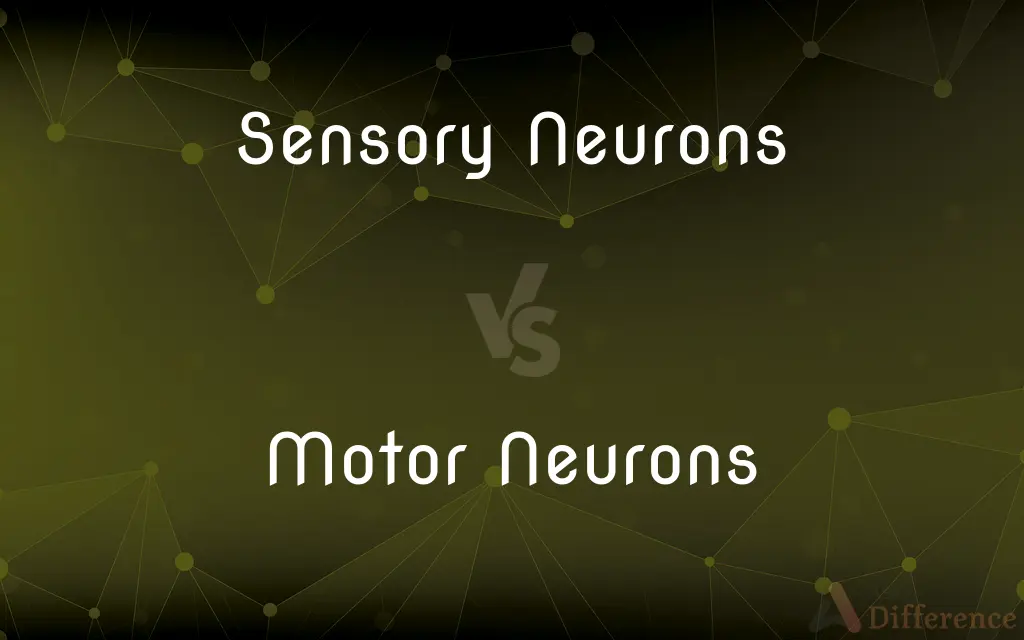Sensory Neurons vs. Motor Neurons — What's the Difference?
Edited by Tayyaba Rehman — By Fiza Rafique — Published on December 3, 2023
Sensory Neurons transmit signals from sensory organs to the central nervous system, while Motor Neurons carry commands from the central nervous system to muscles and glands.

Difference Between Sensory Neurons and Motor Neurons
Table of Contents
ADVERTISEMENT
Key Differences
Sensory Neurons are responsible for converting external stimuli from the environment into internal electrical impulses. On the other hand, Motor Neurons convey signals from the brain and spinal cord to activate muscles and initiate movement.
In the realm of the body's communication network, Sensory Neurons serve as the information gatherers, bringing data from the periphery to the brain. Contrarily, Motor Neurons act as executors, implementing the brain's directives by stimulating muscle contraction.
The functioning of Sensory Neurons can be likened to informants, communicating the feel of a hot surface or the scent of a flower to the brain. In contrast, Motor Neurons function as the enforcers, causing your hand to pull away from that hot surface or turn towards the fragrant flower.
Within the intricate wiring of our nervous system, Sensory Neurons have their cell bodies often located in the spinal ganglia, processing sensory information. Conversely, Motor Neurons have their cell bodies within the spinal cord, directing motor output.
Fundamentally, while Sensory Neurons act as the messengers, bringing feedback to the brain about the external and internal environment, Motor Neurons are the responders, executing the brain's responses through muscle action or gland secretion.
ADVERTISEMENT
Comparison Chart
Function
Transmit sensory information
Initiate muscle/gland actions
Direction of Impulse
From body to CNS
From CNS to body
Cell Body Location
Often in spinal ganglia
Within the spinal cord
Examples of Action
Detecting heat
Pulling hand from heat
Relation to Environment
Reactive to external stimuli
Responders to stimuli
Compare with Definitions
Sensory Neurons
Cells responsible for converting external stimuli into internal impulses.
Sensory Neurons enable us to sense the aroma of freshly baked bread.
Motor Neurons
Electrical conduits for motor responses.
Motor Neurons are activated when dancing to a beat.
Sensory Neurons
Electrical pathways for sensory perceptions.
Sensory Neurons allow us to hear the subtle notes in a musical piece.
Motor Neurons
Cells responsible for initiating movement and action.
Motor Neurons fire, causing the legs to sprint towards the finish line.
Sensory Neurons
Nerve cells that transmit sensory information.
Sensory Neurons relay the sensation of touch when a feather brushes the skin.
Motor Neurons
Nerve cells that transmit signals to muscles and glands.
Motor Neurons enable fingers to pluck a guitar string.
Sensory Neurons
Convey signals from sensory organs to the brain.
Sensory Neurons in the eyes send visual data to the brain for processing.
Motor Neurons
Executives of the nervous system causing muscle contraction.
Thanks to Motor Neurons, we can clap to the rhythm of a song.
Sensory Neurons
Informants of the nervous system conveying external data.
When we touch something cold, Sensory Neurons communicate this to the brain.
Motor Neurons
Carry commands from the central nervous system to the body.
When deciding to move a hand, Motor Neurons make it happen.
Common Curiosities
What role do Motor Neurons play in movement?
Motor Neurons transmit commands from the central nervous system to muscles, initiating movement.
Where are the cell bodies of Sensory Neurons often located?
The cell bodies of Sensory Neurons are often located in spinal ganglia.
How do Motor Neurons interact with muscles?
Motor Neurons carry signals that cause muscles to contract, leading to movement.
Do Sensory Neurons detect both external and internal stimuli?
Yes, Sensory Neurons can detect both external stimuli like temperature and internal stimuli like blood pressure.
Are Sensory Neurons involved in taste and smell?
Yes, Sensory Neurons play a role in transmitting information related to taste and smell to the brain.
What happens when Motor Neurons are damaged?
Damage to Motor Neurons can lead to muscle weakness, twitching, or even paralysis.
Why is the proper functioning of Sensory Neurons crucial?
Sensory Neurons provide essential feedback about our environment, helping in navigation and safety.
How do Sensory Neurons aid in vision?
Sensory Neurons in the eyes transmit visual information to the brain for processing.
What do Sensory Neurons primarily transmit?
Sensory Neurons primarily transmit sensory information from the body to the central nervous system.
How do Sensory Neurons contribute to the sense of touch?
Sensory Neurons convey tactile information, like pressure or temperature, from the skin to the brain.
Can Motor Neurons activate glands?
Yes, Motor Neurons can stimulate glandular actions along with muscle contractions.
How do Motor Neurons respond to brain signals?
Motor Neurons receive and execute commands from the brain, causing muscle contraction or relaxation.
Which neurons, Sensory or Motor, are involved in reflex actions?
Both are involved; Sensory Neurons detect a stimulus while Motor Neurons execute the reflex movement.
Can we consciously control the firing of Motor Neurons?
While many Motor Neuron actions are voluntary, some, like heart contractions, are involuntary.
Are Motor Neurons found throughout the body?
Yes, Motor Neurons are present wherever there's a need to activate muscles or glands.
Share Your Discovery

Previous Comparison
X265 vs. X264
Next Comparison
Intel Compute Stick vs. Raspberry Pi 3Author Spotlight
Written by
Fiza RafiqueFiza Rafique is a skilled content writer at AskDifference.com, where she meticulously refines and enhances written pieces. Drawing from her vast editorial expertise, Fiza ensures clarity, accuracy, and precision in every article. Passionate about language, she continually seeks to elevate the quality of content for readers worldwide.
Edited by
Tayyaba RehmanTayyaba Rehman is a distinguished writer, currently serving as a primary contributor to askdifference.com. As a researcher in semantics and etymology, Tayyaba's passion for the complexity of languages and their distinctions has found a perfect home on the platform. Tayyaba delves into the intricacies of language, distinguishing between commonly confused words and phrases, thereby providing clarity for readers worldwide.
















































